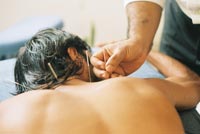
Injecting life to a dying traditionAs a practitioner of acupuncture and natural medicine, Dr. Nalin Perera, is one of a dying breed. His rooms are white and cool, and surprisingly quiet for their location on a road just off Nugegoda junction. His patients, whom he sees in the mornings and evenings, receive the benefit not only of a medical art that is over 5,000 years old, but of its practitioner’s many years of experience. For Dr. Nalin, his practice is more than just a livelihood; it is also an enduring passion. Acupuncture has been an essential part of traditional medicine in many parts of the world, he reveals, adding that though it is believed to have originated in China, it was also practised in India and in Sri Lanka as well. Dr. Nalin himself is from a family that boasts generations of healers. “We come from the very old temple tradition,” he explains, adding that common treatments included not only ailments that beset the body, but those that plagued the mind as well.
Traditionally, there were three systems of treatment, he reveals. The first acupuncture, involved the use of slender needles. The second, known as acupressure was most commonly administered as a massage. The third was the lesser known moxibuxtion which involved an exacting application of heat. “In the Sri Lankan tradition, they used to burn the point directly,” he says, explaining that even today he sees old people who still sport the burn marks from this treatment. But it is with acupuncture that Dr. Nalin has his closest acquaintance. Acupuncturists believe that there is a ‘life energy’, he explains, adding that the Japanese know it as Qi and the Chinese know it as Chi. “This life energy flows on certain pathways, and these pathways are also interconnected with certain internal organs. When a person is in good health, there is a smooth flow of energy and everything is in equilibrium.” However, when someone is ill, this very flow is disrupted. Blockages appear where the energy stagnates, or there may be an excess in one part or a deficiency in the flow of energy to an organ. “An acupuncturist will have to identify where this excess or deficiency is, and unblock those channels so that the flow can take place smoothly,” he explains. Filiform needles of varying sizes are inserted in a process that is reported to be quite painless. Contrary to popular expectation, the more skilled a practitioner, the fewer needles he utilises. An average patient would require about ten sittings, with two or three every week. Often it is less. Acute back pain for instance might be alleviated within four sittings, but a chronic condition could take much longer. As in ancient China, Dr. Nalin may prescribe appropriate herbal medicines to complement the acupuncture sessions. “Unfortunately, most of the patients who come to us have already exhausted everything that western medicine can offer,” he says. As a result of this the condition is often very complex – “it has gone very deep and it has become established.” Many are pain related conditions - back problems, migraine headaches, nerve problems are most common – though acupuncture offers treatments for illnesses like fever and cold as well. Treatment may vary dramatically from patient to patient even if they have the same complaint – say a headache. “There’s no cook-book standard approach,” he says, “we treat the patient, the whole person, not the disease and always the cause not the effect.” Happily, acupuncture is not only cheaper than its western competitor, it also has no side effects – “the only effects are good effects,” he says. “Basically acupuncture has five main actions,” he explains, counting them off. “One is a strong immune enhancing effect - it helps to boost your immunity. Second, analgesic effect – it relieves pain. Thirdly it has an anti-inflammatory effect – it reduces inflammation. Fourth it has a very powerful sedative effect – it can calm a person who is severely agitated. And lastly, it also has a tonifying effect – if a person has very low energy or is drained, with acupuncture you can give a sudden tonification.” “Based on the effect we want we select the points,” he says. Like his grandfather before him, Dr. Nalin is adept at pulse diagnosis, something he says one can only learn alongside an already accomplished practitioner. Descriptions of the pulse are almost poetic, and include descriptions like ‘taut like a bowstring’, ‘the sound of a pearl running along a basin of water’. Traditionally, practitioners relied on direct examination of their patients, examining the eyes, mouth, smell, skin texture among others. These days, in addition to this, Dr. Nalin also examines lab reports. Changes like this are creeping in everywhere, and while he is willing to adapt to the times, Dr. Nalin still retains great respect for the ancient practitioners. He has built up a collection of traditional masks, implements and ola leaf books, complete with intricate diagrams of pressure points on both humans and animals. He has travelled extensively not only in Sri Lanka but in India and Africa as well, and has interviewed many doctors, photographing and documenting their practices in an attempt to preserve these dying arts. It is strangely fitting that, as a practitioner of an old medical art, he is himself a rarity. |
|| Front
Page | News | Editorial | Columns | Sports | Plus | Financial
Times | International | Mirror | TV
Times | Funday
Times || |
| |
Copyright
2007 Wijeya
Newspapers Ltd.Colombo. Sri Lanka. |
